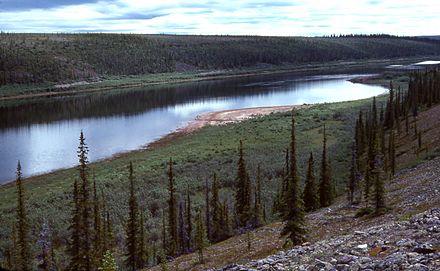Thelon Wildlife Sanctuary
| Thelon Wildlife Sanctuary | |
|---|---|
 The "oasis" section of the Thelon River, below Warden's Grove. | |
| Location | Northwest Territories and Nunavut, Canada |
| Coordinates | 64°49′59″N 102°10′00″W / 64.83306°N 102.16667°W / 64.83306; -102.16667[1] |
| Area | 52,000 square kilometres (20,077 sq mi) |
| Established | 1927 |
| Governing body | Nunavut Parks |
| nunavutparks.com/parks-special-places/thelon-wildlife-sanctuary/ | |
The Thelon Wildlife Sanctuary, at 52,000 square kilometres (20,077 sq mi),[2] over twice the area of Belgium, is the largest wildlife refuge in Canada.[3] It is located in northern Canada's Arctic region, north of the tree line, straddling the Northwest Territories and Nunavut, halfway between Baker Lake and Yellowknife, and bordered on the north between the Baillie River on the west and the Consul River at the east by the Back River.[4] It is the namesake of the Thelon River, whose river valley is resplendent with boreal forest biological diversity, hence its identification as a "Biological Site of Universal Importance" by the International Biological Program (IBP) in the 1960s.[5]
Established in 1927 as the Thelon Game Sanctuary to conserve muskox populations,[2] its original size was 39,000 square kilometres (15,000 sq mi). It was expanded in 1956 to its present size, and is home to the most northernly known moose above the tree line. In addition, the wildlife sanctuary is home to barren-ground caribou (Beverly and Bathurst herds), Arctic wolf, Arctic fox, wolverine, Arctic squirrel (sicsic), barren ground grizzly bear and waterfowl.[6]
The "Thelon Oasis" is a section of the wildlife sanctuary along the Thelon River valley between Warden Grove (the Thelon's confluence with Hanbury River) and Hornby Point. Even though it is north of the Arctic tree line, the area supports thick white spruce tree groves, raspberry, currant, and columbine plants, along with tall alluvial dwarf willow thickets and tag alder. Scientists believe the causes of this unusual proliferation of plants more common to subarctic areas include favorable fine-textured soils and climatic oasis effect, higher summer temperatures due to northward elevation fall and the absence of large lakes.[4][7]
The wildlife sanctuary is also the ancestral home of Akilinirmiut, Inuit of the Akiliniq, a hilly area by the shores of Beverly Lake (Tipjalik). While there are many lakes within the Thelon Wildlife Sanctuary, Beverly Lake is notable as the widening of the Thelon River at its northeastern border within the wildlife sanctuary, and the end of the spruce tree groves.[4]
The wildlife sanctuary teems with game but is a hunting free zone, with support from the Inuit of Baker Lake.[8]
A study of the history of the sanctuary would do well to include studying British explorer John Hornby (1880–1927).
References
- ^ "Thelon Game Sanctuary". Geographical Names Data Base. Natural Resources Canada. Retrieved 2010-08-06.
- ^ a b "Overview". Thelon Wildlife Sanctuary. Nunavut Parks. Archived from the original on 2011-07-14. Retrieved 2010-08-06.
- ^ Pelly, David F (March 2000). "Snow Man: John Hornby in the Barren Lands, by Malcolm Waldron" (PDF). Arctic. 53 (1): 80–81. doi:10.14430/arctic881. ISSN 1923-1245. Retrieved 2010-08-06.
It was Hornby who planted the seed that grew into what is today Canada's oldest and largest fully protected pocket of wilderness, the Thelon Wildlife Sanctuary.
- ^ a b c Currie, Douglas C; Giberson, Donna; Adler, Peter H (Fall 2002). "Insect biodiversity in the Thelon Wildlife Sanctuary". Newsletter of the Biological Survey of Canada (Terrestrial Arthropods). 21 (2).
- ^ "The Thelon Wildlife Sanctuary, Northwest Territories & Nunavut, Canada, Canada's Wilderness Jewel". thelon.com. Retrieved 2008-01-16.
- ^ "Thelon Heritage River and Thelon Wildlife Sanctuary" (PDF). Nunavut Parks. Retrieved 2010-08-06.
- ^ Timoney, Kevin (March 1995). "Tree and tundra cover anomalies in the subarctic forest-tundra of northwestern Canada" (PDF). Arctic. 48 (1): 13–21. doi:10.14430/arctic1220. ASTIS record 35665. Retrieved 2010-08-06.
- ^ "Features". Thelon Wildlife Sanctuary. Nunavut Parks. Retrieved 2010-08-06.
Videography
- LaRose, John. The Place Where God Began The Thelon Wildlife Sanctuary, a Northern Oasis. [Ottawa, Ont.]: Summerhill Entertainment, 2000.
External links
- Official web site
- Map1, Map2
- Historical Timeline of the Northwest Territories 1928 - William Hoare and the Thelon Game Sanctuary, Prince of Wales Northern Heritage Centre